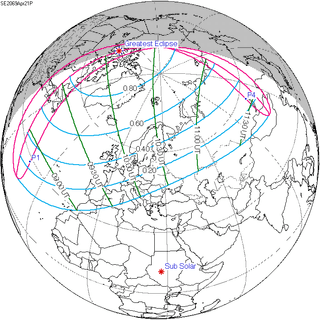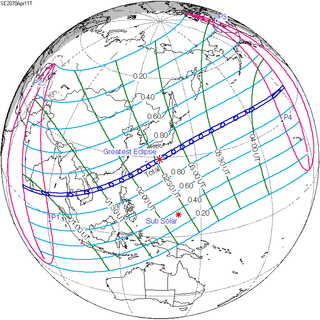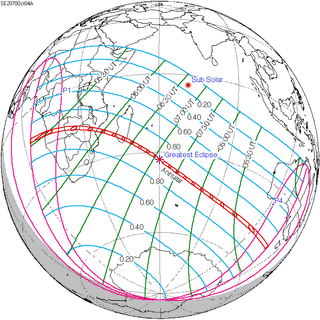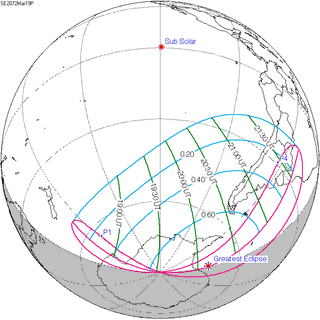Solar eclipse of March 31, 2071
| Solar eclipse of March 31, 2071 | |
|---|---|
 Map | |
| Type of eclipse | |
| Nature | Annular |
| Gamma | -0.3739 |
| Magnitude | 0.9919 |
| Maximum eclipse | |
| Duration | 52 sec (0 m 52 s) |
| Coordinates | 16°42′S 37°00′W / 16.7°S 37°W |
| Max. width of band | 31 km (19 mi) |
| Times (UTC) | |
| Greatest eclipse | 15:01:06 |
| References | |
| Saros | 140 (32 of 71) |
| Catalog # (SE5000) | 9667 |
An annular solar eclipse will occur on March 31, 2071. A solar eclipse occurs when the Moon passes between Earth and the Sun, thereby totally or partly obscuring the image of the Sun for a viewer on Earth. An annular solar eclipse occurs when the Moon's apparent diameter is smaller than the Sun's, blocking most of the Sun's light and causing the Sun to look like an annulus (ring). An annular eclipse appears as a partial eclipse over a region of the Earth thousands of kilometres wide.
Related eclipses
Solar eclipses 2069-2072
Each member in a semester series of solar eclipses repeats approximately every 177 days and 4 hours (a semester) at alternating nodes of the Moon's orbit.
| 120 | April 21, 2069 Partial |
125 | October 15, 2069 Partial |
| 130 | April 11, 2070 Total |
135 | October 4, 2070 Annular |
| 140 | March 31, 2071 Annular |
145 | September 23, 2071 Total |
| 150 | March 19, 2072 Partial |
155 | September 12, 2072 Total |
References
| Wikimedia Commons has media related to Solar eclipse of 2071 March 31. |
External links
- Earth visibility chart and eclipse statistics Eclipse Predictions by Fred Espenak, NASA/GSFC

